Leaders are calling for more transparency in lab animal research, urging that it’s critical for the future of biomedical science. Biomedical research with animals is fundamental for the health and well-being of people and animals everywhere. Furthermore, research with laboratory animals has contributed to nearly every medical cure or treatment available to people and pets. So, why is the industry so hush-hush about these incredible accomplishments? Why is there so little transparency in lab animal science? And what difference does it make? 2
A primary reason for the historically closed-up and private nature of professionals in laboratory animal research is the potential threats and violence they face from special interest groups that oppose animal research. For example, Cindy A. Buckmaster, Ph.D., CMAR, RLATG, discusses on her podcast “GetReal!” some traumatic experiences of her colleagues who have been victims of physical and verbal harassment from these groups. 2
The bottom line is transparency could make a lasting difference in laboratory animal research. Experts and advocates for more openness believe it’s critical because it will help improve public opinion, which can help reduce violence and opposition towards science. Altogether, more transparency could foster more science and better science. 5
Here are some powerful ways individuals and organizations can contribute to achieving more transparency in the laboratory animal science community.
1. Encourage Lab Animal Professionals to Share Their Stories to Create More Transparency in Lab Animal Research
Cindy Buckmaster is a champion advocate for more transparency and open communication in laboratory animal science. So much so that her podcast, “GetReal!” is dedicated to open and honest conversations with laboratory animal professionals and experts about their heroic work in biomedical research with animals. Buckmaster believes that one way to improve transparency and sincerely give the public a better understanding of laboratory animal research is to encourage and support lab animal professionals to share their stories. 2
Buckmaster points out that special interest groups dominate the mainstream conversations about laboratory animal research. For example, “most of the information shared by these groups is misleading or entirely fabricated. And while they spread false narratives about the need for animals in research and how they are treated, the research community is mostly silent,” describes Buckmaster on her podcast. 2
Buckmaster and other experts believe the way to counteract the overload of false information spread by special interest groups is for laboratory animal professionals to share their stories. And as Buckmaster points out, as diverse as those stories tend to be, they all seem rooted in a very similar place. Collectively, they are rooted in deep respect and love for animals. And all with a desire to improve life and health for humans and their pets. 2
For example, the website www.comeseeourworld.org, is dedicated to being fully transparent about lab animal research and showing the caring side of it. It showcases the fundamental role of lab animal research in curing diseases and the stories of people who work in lab animal science. They also believe that more positive exposure to the public about the lives and stories of people who work in animal research could transform public views and understanding of lab animal science. 4
2. Make University Website Pages More Open About the Laboratory Animal Research Programs They Offer
During the presentation, Improving Openness in Animal Research, given at the Max Delbrück Center, Berlin, for a European Animal Research Association (EARA) event supported by the Federation of European Neuroscience Societies and the Society for Neuroscience, Kirk Leech, the Executive Director of the EARA, explains the “urgent necessity to improve public understanding and acceptability of animal research.” 5
Leech suggests one way to improve transparency in laboratory animal research is by better-representing lab animal research programs on university websites. To understand this better, the EARA investigated the websites of public universities in Germany with laboratory animal research programs. 5
Here’s what they looked at:
- Do the websites say anything about animal research?
- Do they have extensive information and specifics about the research projects undertaken there?
- Are there any images/videos of lab animal research projects?
They found that 57% of the websites did not mention lab animal research. They also found that 77% of the websites had no information or specifics about their animal research projects, and 77% had no images or videos. Of the 33% of universities that used photos and videos, 25% of those images and videos were from agencies, not actual pictures from their programs. 5
In the workshop, Leech highlights how this is an opportunity for the laboratory animal science community to improve transparency. If universities aren’t sharing this information, who is? Showing the public lab animal research on accredited university websites will help people accept and understand it better.5
For example, images and videos like these accurately depict what lab animal research is. If people had more access to this kind of media, they might be more supportive and understanding.
3. Emphasize the Importance of Biomedical Research with Animals
The impact biomedical research with animals has on society is immense. For example, “animal research plays a fundamental role in medical, veterinary and scientific progress. From the development of insulin and transplant surgery to modern-day advances, including gene therapies and cancer treatments, animals – from mice to monkeys – continue to play a crucial role in basic and applied research. And it’s not just humans that benefit – every veterinary treatment in existence is possible thanks to studies on animals.” 6

And according to Buckmaster, “Everyone deserves to know why we do this work and how we do it, and we have a moral and professional obligation to educate them. People won’t stop hating us until we do.” 1 If laboratory animal science professionals don’t speak up about the critical role of animal studies, who will? According to Buckmaster, the lab animal science community must inform the public about how biomedical research impacts global health. For example, the public perception could improve if more organizations spoke about their roles in developing vaccines.
For More Open Conversations and Transparency in Lab Animal Research with Experts, Check Out Our Webinars
Are you interested in being a part of more transparent and open conversations about pain points and success stories in the laboratory animal science field? Check out our monthly webinar series to keep up on the latest stories told by experts in the laboratory animal research community. Last month, Jori K. Leszczynski, DVM, DACLAM, discussed “Strategies to Improve Personnel Management.” For a summary, check out our blog, “The Best Way to Onboard New Lab Animal Professionals.”
References:
- Buckmaster, Cindy A. “Either Open Up, or Give Up.” Lab Animal, vol. 44, no. 8, 2015,
- Buckmaster, C. (Host). (2021, October 29). Full Transparency or Bust (No.9) [Audio podcast episode]. In GetReal!
https://www.getreal.naiaonline.org/episodes
pp. 325–325., https://doi.org/10.1038/laban.825. - “Home.” CARING FOR ALL, https://care.aalas.org/care/.
- Leech, Kirk, The European Animal Research Association. (2019, February). Kirk Leech: EARA Event, Improving Openness in Animal Research in Germany, Berlin, July 2018. YouTube. http://www.youtube.com/watch?v=QweZuUoW_ho
- Mayday, John. Nobel Prize Winners Call for Greater Openness in Animal Research … 20 June 2018, https://www.bovinevetonline.com/news/industry/nobel-prize-winners-call-greater-openness-animal-research.

